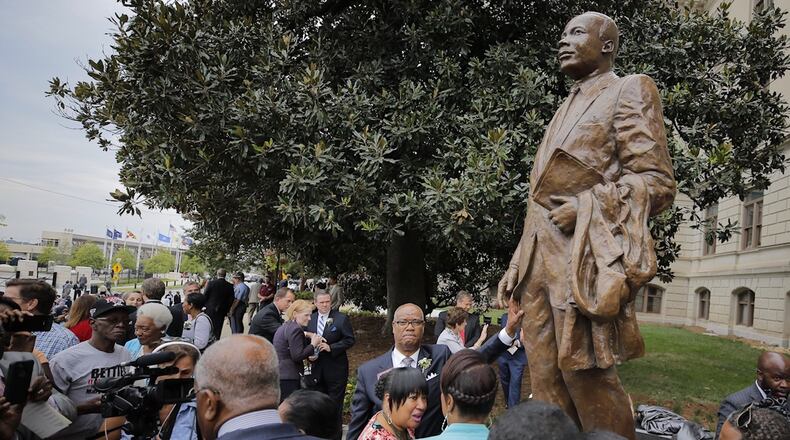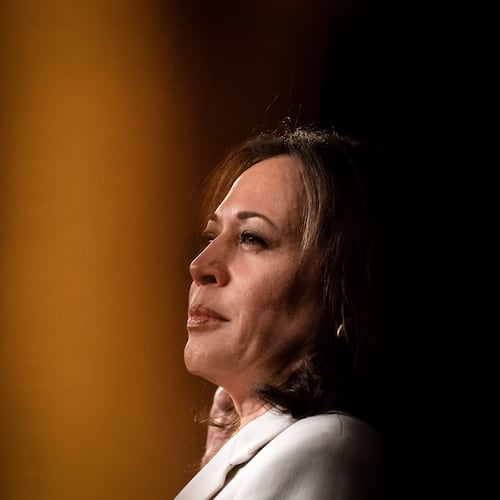The photograph, taken at the Monday dedication of a statue to the Rev. Martin Luther King Jr. at the state Capitol, freezes the scene that followed Gov. Nathan Deal’s adjournment of the gathering.
At the bottom of the frame, the King family is besieged by cameras and reporters. In the distance, the governor’s entourage is making an exit into the building. But at the quiet center of this tumult, captured by the Journal-Constitution’s Bob Andres, is an older black man in the midst of a very private moment.
Calvin Smyre’s left hand is on the statue, fingers savoring the clean feel of recently poured bronze. But his eyes stare off into space, and lips are pressed together in the attempt to hold back the tears. It is a single photograph, so we do not know if he succeeded. Probably not.
We have told you that the MLK statue was the initiative of the governor. Deal pitched the idea on King Day in 2014. But a white Republican isn’t necessarily equipped to navigate the unfamiliar waters of the civil rights world. Deal needed a partner, and that partner was a Columbus Democrat named Smyre. (Pronounced SMY-ree)
He’s the man in the center of the photograph.
If you want to know why the King statue is where it is, why the brown bronze nearly matches the complexion of the slain civil right leader, and why King’s famed fedora is missing, Smyre is the man with the start-to-finish answers.
Smyre, 70, is a retired bank executive and the longest-serving member of the Legislature. Back in the days of Bill Clinton and Barack Obama, he could pick up the phone and get the White House. But even as a Democrat living in a Republican world, he’s been in the room where it happens more often than anyone in the state Capitol — in large part because he is quiet, discreet and connected.
And he never hogs the credit.
Smyre never met King, who was assassinated when he was a sophomore at Fort Valley State. But as a young man, the legislator said he took some advice on politics from a famous King follower, Hosea Williams. “He said, if you want to get into politics, get inside the game,” Smyre said.
And that Smyre has done. He is a man of relationships.
Pressed for a brief word of commentary on Smyre’s role, the governor’s chief of staff, Chris Riley, responded with a text-torrent that filled several screen loads.
The Deal-Smyre connection goes back more than 20 years, Riley said, to when Congressman Deal bolted to the Republican party. The next time the Legislature met to redraw congressional lines, Deal became a target of the Legislature, then in its last full decade of Democratic control.
“The only member of the conference committee on congressional redistricting that would speak to me in public was Calvin Smyre,” said Riley, who even then was Deal’s top aide.
His office door has been open to Smyre ever since.
At the governor’s request, Smyre carried House Bill 1080, the measure that authorized the statue. (Ever the diplomat, Smyre would have you know that state Rep. Tyrone Brooks, D-Atlanta, had already introduced a resolution urging a statue for King in that 2014 session.)
But a truer sign of the trust between the two men came a year later, when Deal signed an executive order giving Smyre the borrowed authority of the governor when it came to negotiations involving the statue — with the King family, the artists, the donors and all the state entities involved in placing several tons of fresh metal on the Capitol grounds.
Smyre was the one who found the first sculptor for the King statue, Andy Davis of McDonough. And when Davis died in a traffic accident in July 2015, it was Smyre who went to the funeral, along with a representative of the King estate.
Every change along the way required shuttling among the new sculptor, Martin Dawe, the King family, a state arts standards commission, and certain people in the Capitol.
In February, the proposed location of the MLK statue was shifted. But this was Smyre’s idea. Originally, it was to be located near the base of the stairs on the Capitol’s eastern side. But that area is largely hidden by trees – including a massive, ancient and state-protected magnolia. (See the background of the photo.)
On the other hand, the more prominent northeast corner of the Capitol only held a small, barely visible monument to 33 black lawmakers expelled from the Georgia Legislature during Reconstruction.
Smyre got into his car, pulled up to the intersection of Capitol Avenue and Martin Luther King Jr. Drive, surveyed both locations from the driver’s seat – and proposed swapping locations of the two monuments. After getting buy-in from the Legislative Black Caucus, of course.
“Looking toward Ebenezer [Baptist Church], on Martin Luther King, looking toward where he grew up, it all made sense,” Smyre said.
Then there’s the color of the MLK statue – a golden brown unlike anything else on the campus. “We debated that,” Smyre said. The sculptor wanted it, but so did Smyre, the King family, and other decision-makers. “We did like that coloring. It’s more modern. It gives more of a positive glow,” the Columbus lawmaker said.
Now, as for the hat. Throughout the process, Smyre was dealing with King siblings who had seen some pretty poor depictions of their father over the last five decades.
“They showed us a lot of photos, showing us what they didn’t want. They’ve gone through this so many times in so many states and communities,” Smyre said. “The likeness and image had to be very precise.”
A constant feature of King’s attire was a broad-brimmed fedora. It was to be a feature of the statue — until testing determined that the hat would always shade the face. Unless expensive lighting were added on the ground, pointing up.
The artist wanted King without the hat. Smyre took the problem to the King family, and they agreed to its removal.
You hat-lovers out there might be asking yourselves why King couldn’t be holding his fedora in his free hand. But the only African-American to be so honored at the Capitol cannot be portrayed hat-in-hand.
If you aren’t familiar with the phrase, go ask a grandparent.
The good news: By ditching the fedora, the sculptor was able to lower the pedestal, making the sculpture more accessible to passers-by, and increase King’s height.
Details like these are what has weighed Smyre down for the better part of three years, and help explain what we see in that photograph.
When I tapped House Speaker David Ralston for this column, he gave due credit to Governor Deal and the Legislature as a whole. But the House leader began his emailed reply to me with a dead-on observation: “There is a whole lot of Calvin Smyre in that statue.”
About the Author
The Latest
Featured




